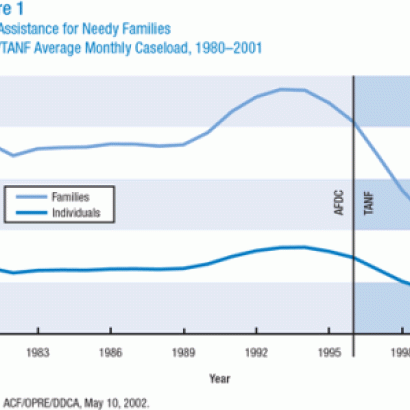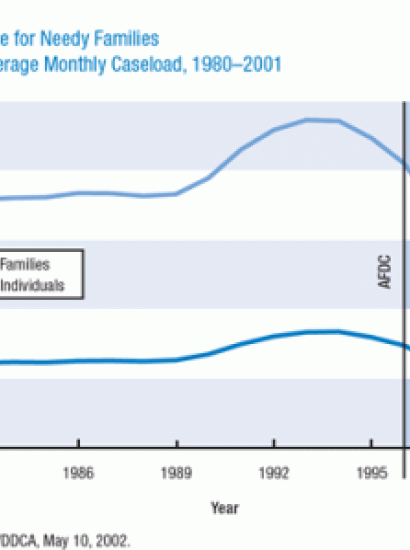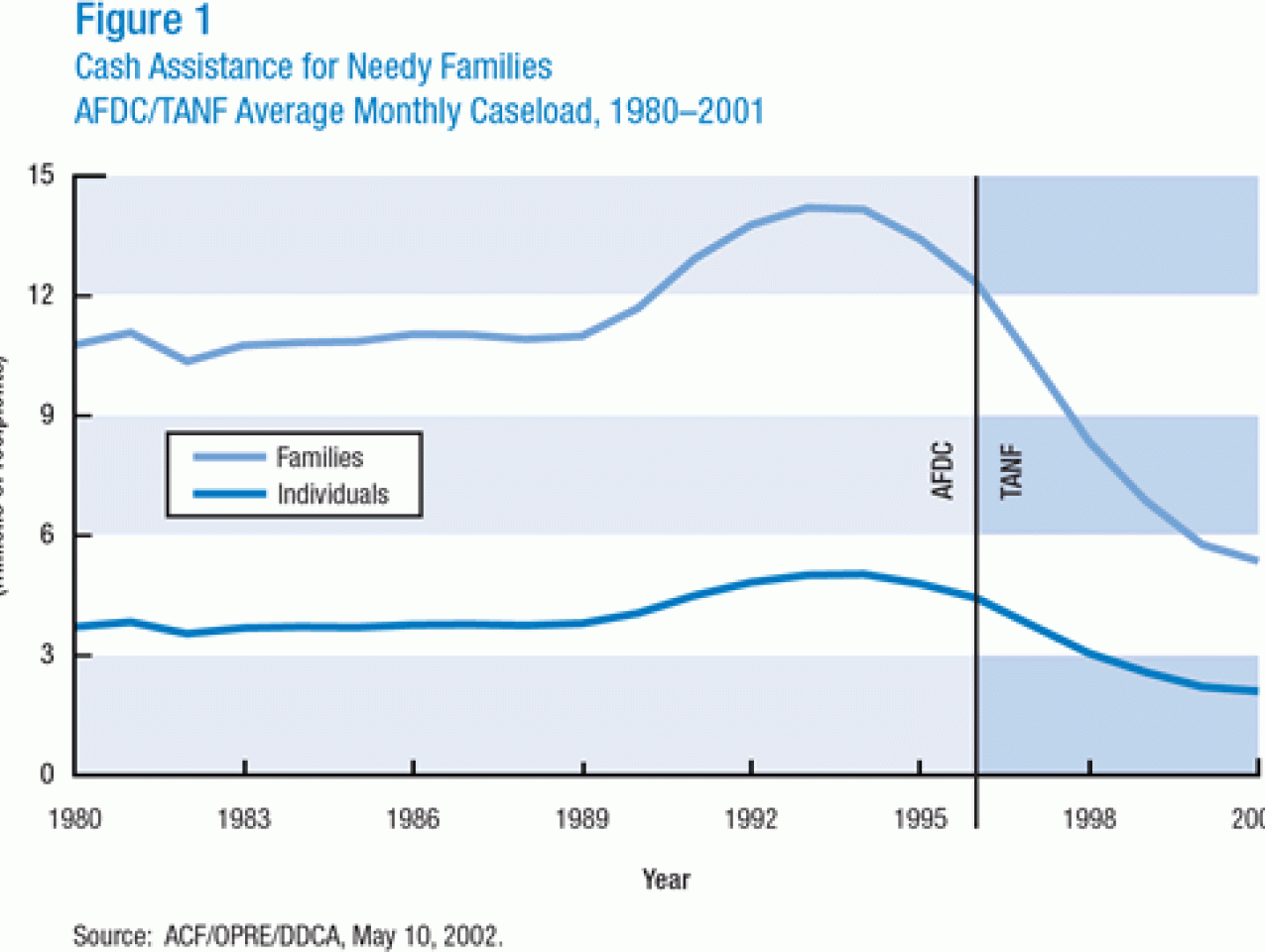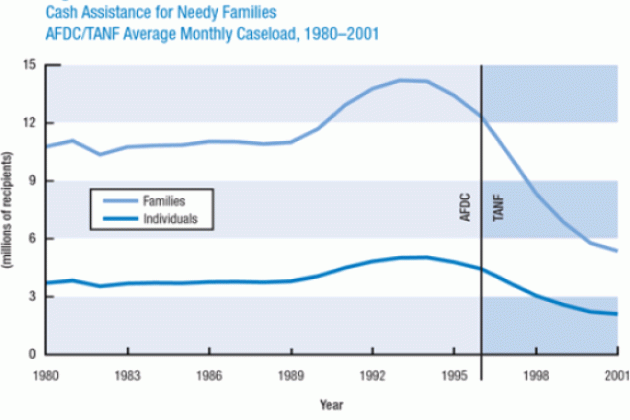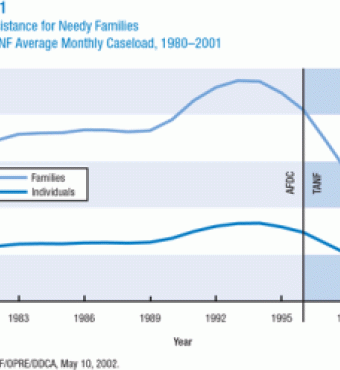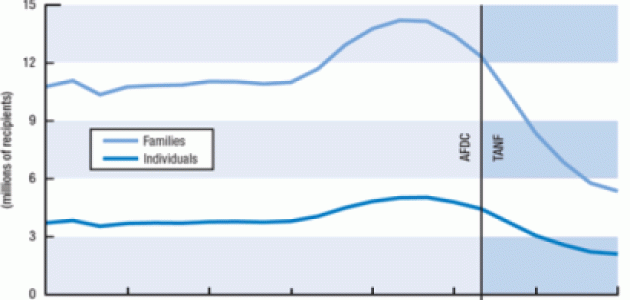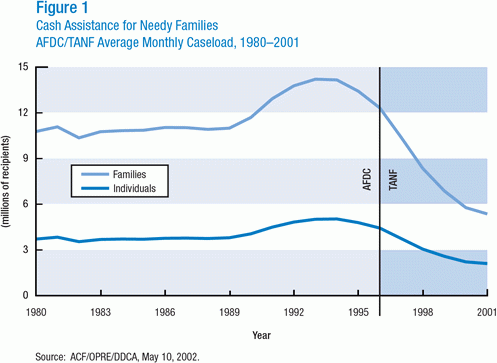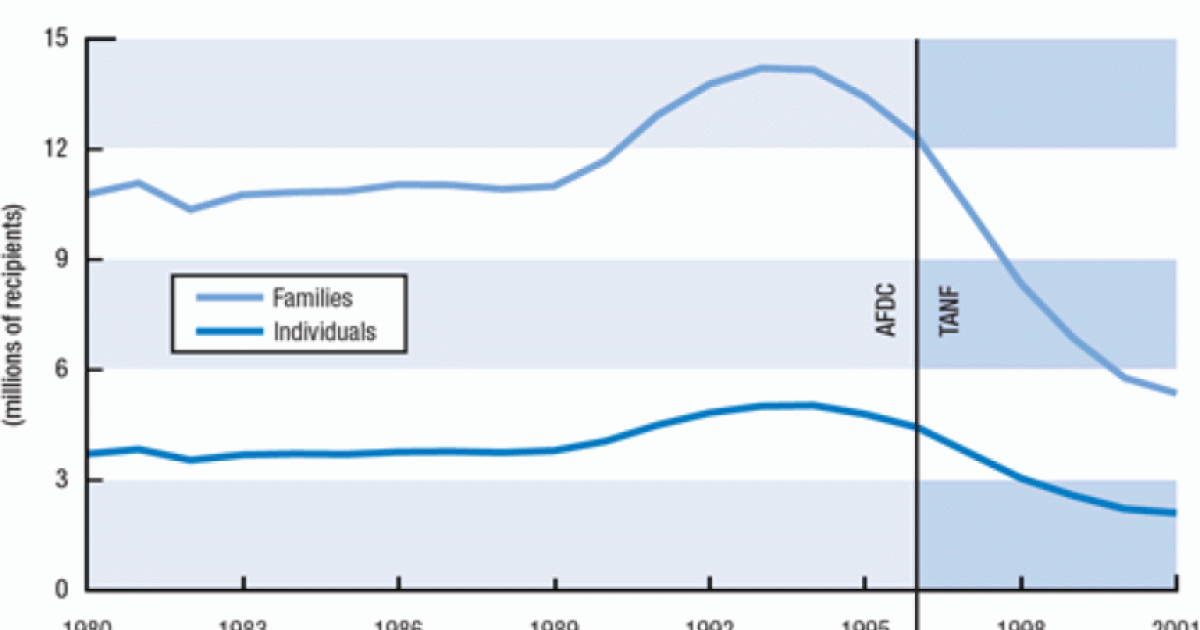- Budget & Spending
- Economics
The pervasive success of the past decade’s boldest legislative experiment has silenced its critics. Shouts of “child impoverishment” and “a moral blot on our nation that will never be forgotten” have given way to mere whispers of disaffection. Welfare reform, passed more than six years ago, is facing reauthorization in a political climate of such favor that scant room is left for opposition, let alone in-depth discussion. Case in point: In early February the House of Representatives passed its version of welfare reauthorization in just 10 days.
What little criticism the House bill engenders tends to focus on the more “controversial” proposals. Democrats denounce efforts to promote marriage and teenage abstinence while petitioning for more child-care funding and eligibility for immigrants. As the reauthorization process continues, it is imperative that we get beneath these surface issues to consider the underlying principles that made welfare reform successful in the first place. If Temporary Assistance for Needy Families (TANF)—the program originated by welfare reform—can be called a triumph, what are the reasons? In crafting the next generation of welfare reform, can we build on this foundation?
Welfare Reform: The First Six Years
There is simply no denying the success of TANF in reducing the number of individuals and families dependent on government cash assistance. Welfare caseloads have dropped a staggering 59 percent since TANF replaced AFDC (Aid to Families with Dependent Children) in 1996, with more than 7 million fewer people and 2 million fewer families receiving benefits (see figure 1).
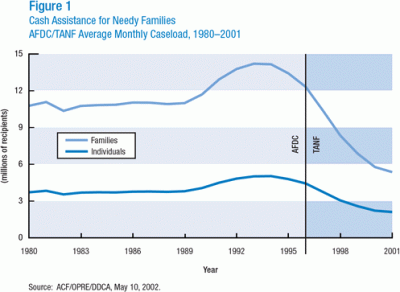
Contrary to the predictions of child impoverishment, today there are nearly 3 million fewer children in poverty. Poverty rates are at an all-time low for black children and for children in single-parent households. Employment among young single mothers has nearly doubled, out-of-wedlock births have remained flat for the past five years, and there are nearly 2 million fewer hungry children. Although stories continue to surface about individual cases of single-parent families slipping through the cracks, overall, TANF has had a positive impact on this nation and its poor. Formerly destitute and dependent welfare recipients are now working by the millions—earning a living and setting a positive example for their children that will reap benefits for our nation well into the future.
What accounts for such success? The 1996 welfare reform package signaled a major departure from the past. For the first time, the federal government took giant steps in getting out of the business of dictating to states how they must support poor families. TANF eliminated cash benefits as an entitlement, sharply reduced federal mandates, and greatly expanded state flexibility.
TANF ended a three-decade guarantee of aid to the poor. Prior to welfare reform, states received an open-ended federal match for cash assistance to needy families, which the states could exercise no discretion in paying out. If a family had children and sufficiently low income, states were obligated to pay cash benefits irrespective of the family’s behavior, compliance, or personal responsibility. TANF, in contrast, instituted block grants: a lump sum of money each state could spend largely as it saw fit. States were then able to condition receipt of welfare on the family’s meeting particular commitments such as entering employment, participating in job searches, or accepting treatment for substance abuse.
Along with rescinding the entitlement to welfare, TANF decentralized the entire welfare delivery system—a process instigated by the removal of cumbersome federal mandates. The mandates governing AFDC burdened those states interested in providing families with a way out of welfare dependency. The result was a “one-size-fits-nobody” welfare system in which state programs were largely distinguished by the size of the welfare checks they handed out. With TANF, a fundamental shift in attitude and mission saw caseworkers giving way to job counselors and dependency giving way to self-sufficiency. Federal oversight switched from monitoring process to monitoring performance as states were rewarded for reducing their caseloads and moving clients into work. What developed were a variety of programs based, in part, on each state’s unique culture and historical approach to social policy. As a result, TANF programs became more coordinated and responsive to local concerns.
The removal of mandates led to an increase in state flexibility and innovation. States began to move beyond the original scope and vision of TANF, shifting the focus from national-level solutions to approaches that worked at state and local levels. The states took full advantage of the opportunity to design their own approaches to supporting poor families and developed a wide array of TANF programs. Many states implemented “work first” strategies, wherein welfare applicants had to quickly secure a job. Others focused on “making work pay,” rewarding clients who found work with a continuation of benefits and support services.
The diversity in TANF program structure is evident when one examines benefit and sanction levels. States varied greatly in the generosity of cash benefits paid to poor families (see figure 2). A family of three, for example, in a low-benefit state, became ineligible for cash assistance if it earned more than $558 per month—an earnings level attained by a single family member working 25 hours a week at $5.15 a hour. In a high-benefit state, this same family could earn more than $1,000 per month through employment and still be eligible for some cash assistance.
For welfare recipients who failed to comply with the rules, states sanctioned families with varying degrees of severity. Some states applied so-called family sanctions, meaning that the entire family, including the children, immediately lost all cash benefits. Other states implemented family sanctions only after multiple episodes of noncompliance. Still others were even less severe, only partially reducing grants to families who failed to cooperate.
No matter which strategy was employed, every state successfully met the federal work participation goal of having 50 percent of recipients engaged in work activities 30 hours a week. By making employment the first priority of assistance, TANF programs succeeded in moving recipients off welfare and into work. The vast majority of states (35) saw their TANF rolls decline 40–70 percent between 1996 and 2001, and 8 states achieved reductions of more than 70 percent. Wyoming led all states with a 91 percent decline in its caseload, whereas Rhode Island brought up the bottom with a 34 percent decrease. Overall, the flexibility built into TANF (as well as solutions it never anticipated) allowed welfare reform to thrive beyond all expectations.
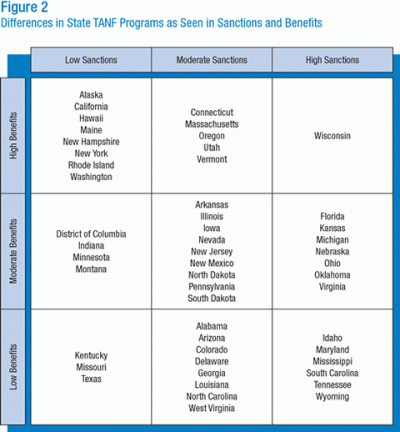
Reauthorization: Going Forward or Back?
What we are witnessing today, on the eve of welfare reauthorization, are the fruits of disentitlement, fewer federal mandates, and greater flexibility. The final reauthorization bill the president signs will likely share a strong resemblance to House Resolution 4, the Personal Responsibility, Work, and Family Promotion Act of 2003, a bill that echoes the president’s own proposal, Working toward Independence. A Senate version, now in the works, is sure to differ in important details, necessitating some sort of a compromise. How do the various proposals for reauthorization build on or tear at the foundational principles that have made the first stage of welfare reform so successful?
Proposals that will improve the system. The proposals reinforce state flexibility with two key revisions. First, they remedy a flaw in the design of TANF that prevented states from spending their unused federal cash assistance funds. The total accumulated over the past few years has risen to more than $2 billion—the savings welfare reform has produced by moving individuals and families into work. Welfare reauthorization will give states increased flexibility in using this “welfare reform dividend” to weather economic downturns and pay for any TANF-authorized benefit, service, or activity.
Second, both the administration and House proposals expand options for interested states to apply for and negotiate waivers to integrate a variety of federal programs—including TANF, Food Stamps, the Workforce Investment Act, and Federal Housing and Homeless Assistance. States can establish demonstration projects to counter the existing inefficiencies and red tape of uncoordinated federal assistance measures. The end result of this new flexibility will be better and more streamlined services for those who need them most.
Reading the popular press might lead one to surmise that TANF re-authorization will place new mandates on the states with programs designed to strengthen marriages, promote abstinence, and improve child support enforcement. But these provisions are not mandates; they are merely pilot programs designated for special incremental funding. Federal priorities—which often change from one administration to the next—are best encouraged through pilot grants, which allow individual states to implement programs targeted at those goals. Irrespective of one’s position, it is difficult to argue that states should not be given the option to pursue these goals at their discretion.
Proposals that go too far. Three of the most critical revisions in the reauthorization proposals—beefing up the workload requirement, phasing out the caseload reduction credit, and increasing the minimum work-participation rate—however, step on the independence of the states.
The first revision, the workload requirement, involves increasing the minimum work week for welfare recipients from between 25 to 30 hours to 40 hours a week and reducing the number of activities that count toward this requirement. If this recommendation becomes law, there is no question that flexibility decreases. States will be restricted in providing activities and tenures they believe are necessary to maximize self-sufficiency, including efforts to address addiction, lack of education, and domestic violence. The hardest-hit states will be those that, under TANF, emphasized work participation over caseload reduction. With fewer activities and more hours to account for, these states will be forced to sanction and remove large numbers of clients who fail to meet the strict guidelines.
The second revision calls for the elimination of the caseload reduction credit by 2005. Over the past six years, states have used this provision to help meet their work participation goals by receiving credit for clients that leave their rolls for reasons other than securing work. Rescinding this credit penalizes states that set high standards for client participation or specifically target caseload reduction. Keeping the credit in place helps states rid the welfare rolls of chronic program abusers—states can sanction or remove these abusers and still meet their participation goals. Eliminating the credit would ensure a steady stream of belligerent and uncooperative clients.
The final revision that affects state independence involves increasing the percentage of TANF families required to participate in work activities from 50 to 70 percent by the year 2007. As a general principle, engaging more recipients in work activities is a commendable goal, but raising the bar another 20 percent will leave little room for states to maneuver as they seek innovative ways to match the remaining 5 million TANF recipients with meaningful work. Making allowances for participants who do not complete a full 40 hours of work activities a week (due to illness, lack of support services, etc.), states will actually need to engage nearly 100 percent of their clients in work activities to meet the heightened federal standard. Such universal participation fails to account for the individual circumstances and local constraints of providing quality welfare-to-work assistance.
Keeping Responsibility with the States
As originally enacted, one of TANF’s goals was for the federal government to relinquish responsibilities and, more important, its onerous regulations on what states can and cannot do. The establishment of strenuous federal standards or performance requirements—such as increasing work participation rates—begins to work against these goals by restricting state flexibility. Such requirements clearly constitute new federal mandates, for a state will not receive its full block grant unless it abides by these proposed new rules.
In proposing such rules the administration and Congress are operating under the false premise that it was federal work standards and time limits that led to TANF’s success. They surmise that, if they raise standards even higher, the states will meet or exceed these heightened expectations. But it was reachable standards that led to TANF’s success in the first place, not stratospheric goals.
TANF was successful precisely because the federal expectations incorporated in its adoption could be met by the states without much difficulty. Not only were some of the goals achievable on their own terms, but each state could use its AFDC matching funds to set up programs and serve clients without regard to TANF. Moreover, the feds introduced the caseload reduction credit explicitly to reduce the bite of their work requirements, rendering them powerless; no state has yet been penalized for not reaching the minimum requirements. States were not looking over their shoulders all the time, fearful of federal standards. They had room to improvise and innovate and were given the resources to attack dependency on welfare while still supporting the least employable.
Continuing this approach has political advantages as well. Fewer federal mandates mean that states and localities with vastly different constituents can craft programs that are viable for their communities. Some communities would prefer to support even the most shiftless welfare recipients rather than see them living on the streets. Other communities would rather have welfare recipients gain self-respect by facing the consequences of their self-destructive behavior. Mercy and responsibility are both legitimate virtues. Is it Washington’s role to decide which virtue is more valuable to the residents of San Francisco or Omaha?
The Important Lessons
In the early 1990s, AFDC was in full operation as the federal welfare entitlement program. Dependency on welfare was growing and approaching the peak it would reach in 1995. In 1992, the federal government began granting waivers to states to design and implement alternative welfare programs, outside the strictly regulated guidelines of AFDC. California, Michigan, New Jersey, Wisconsin, and Oregon were among the first states granted waivers; by August 1996, 43 states had received AFDC waivers. The wisdom of allowing a little more flexibility, and fewer mandates, eventually culminated in the abolition of the old, broken welfare system. Its replacement was, in essence, the federal government’s response to state aspirations. Transferring responsibility for welfare programs to the states has been an incontestable success.
Proposals appearing for TANF’s reauthorization suggest that Congress and the administration have not learned the crucial lesson of welfare reform: Keep mandates to a minimum and trust states to go their own way in responding to the social, political, and economic forces within their localities. All states have succeeded in their mission to support poor families, even though they have chosen different paths. With block grants in place, mistakes made by the various states will be paid for by their taxpayers.
Success should breed more success. Instead of returning to pre-TANF notions of federal and state responsibilities, we should apply the lessons of welfare reform to the task of transforming other federal assistance programs—Food Stamps, SSI, Medicaid, housing assistance—for the better. The diversity of approaches, rather than one federally approved approach, spurs innovation and competition between the states. Greater flexibility, fewer mandates, and a restricted right of the federal government to impose its objectives will bring the next wave of success in the fight for individual and family independence. When states are free to develop their own programs, the results speak for themselves. Successful programs will be emulated by other states, and unsuccessful ones will lose support and fade away. Ultimately it is the competition of ideas that will allow the best “national” welfare system to materialize.








